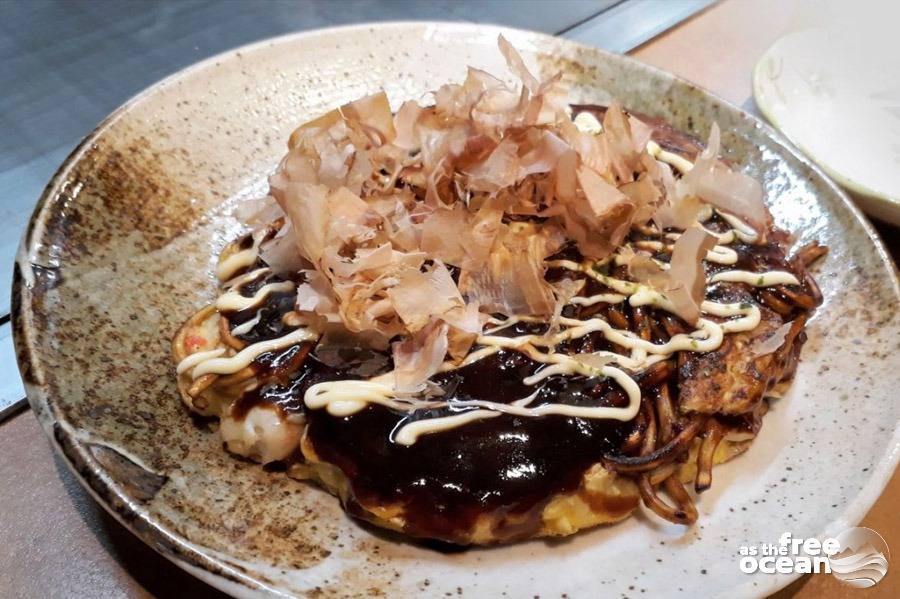For us, besides seeing places, trying the different foods of each country that we visit plays an important role during our journey. We love to immerse ourselves in the culinary world and experiences new flavors that our taste buds can enjoy. Japan is a country where gourmets will find an endless number of culinary pleasures, that’s why we listed some of our favorite foods that we think you should not miss while being in Japan.
- Udon
Udon are Japanese noodles made from wheat flour, water and salt. The noodles are the thickest in Japanese cuisine. They are prepared in many different dishes. Some of the best-known Udon dishes are:
Kake-Udon: are doused with broth based on soy sauce.
Bukkak-Udon: are mixed with various ingredients and then doused with hot water.
Kitsune-Udon: are cooked in hot broth and with deep fried tofu (Alex’s favorite Udon).
Kamatama Udon: are served with some broth and raw egg (my favorite Udon).
- Okonomiyaki
Okonomyaki is my favorite dish in Japan, although I did not know it before. “Okonomi” means taste and “yaki” means grilled or fried. The base consists of water, cabbage, flour and egg. Depending on your preference, different ingredients such as cheese, fish, meat etc. can be added. Each one of these ingredients is typical for a different region. The dish is prepared on an iron plate and in some restaurants you can fry the Okonomiyaki yourself. Depending on the type, first the base is being formed. It can be associated with a crepe, being filled and turned after a short roast.

- Sushi
Not rare I heard from people: “Sushi? That’s not for me, that’s nothing proper to eat “or” Sushi is just something for snobs! ”
No idea why people think so, because there are many sushi types in different flavors, there should actually be something for everyone. As many things in Japan, sushi might seem an expensive thing to try, but there are cheap alternatives, like running sushi. Even in Tokyo, we could find good sushi at a reasonable price. (Click here for our best Sushi experience). Small Sushi vocabulary: Shari (斜里) = Expression for sushi rice in the sushi bar
Namida (涙) = Tears:
Wasabi, which is located between the rice and the stuffing or toppings. It reflects the tears that come to you when you eat it. (Japanese basically do not eat very spicy) And yes, in Japan wasabi is not served separately like in Europe.
Gari (ガリ) = Crunch:
This is the ginger that is served with the sushi. The word refers to the crunchy sound when you eat or cut it.
Murasaki (紫) = Purple:
This is the soy sauce, so-called because of its purple shimmering color. Important: It is taboo to waste soy sauce or “drown” the sushi in the sauce.
By the way, it’s okay to eat sushi with your hands. It used to be finger food, but we did not see anybody doing it. There is nothing wrong with the sushi you find in the supermarket. Mostly sushi is offered in Izakaya restaurants (small Japanese bars) or sushi from the line (Jap: Kaiten-zushi or Mawari-zushi).

- Onigiri
Our little lifesavers in Japan were the Onigiri. These rice snacks can be found in supermarkets and also in Convenient stores (Seven Eleven or Lawson for example) and have different fillings. Perfect for a snack in between.

- Ramen
Isn’t Ramen a Chinese noodle soup? Yes and no! Undoubtedly, the roots of Ramen come from Chinese cuisine and like many other foods it was implemented in Japan after 1859, when the ports were opened.
The father of ramen is the Chinese noodle soup, but the mother is the Japanese food culture. – Quote from the Yokohama Ramen Museum
The difference between normal Chinese noodles soup and Ramen are the ingredients. While for the Chinese noodle’s soup is always the same, the different types of Ramen are based on different types of soups. The five elements of the Ramen are broth, toppings, oil, spices, noodles. Ingredients are matched depending on the region.

- Mochi
Mochi is a Japanese sweet made out of sticky rice (Mochiko). Some Mochi species are filled with Anko (red bean cream) or wrapped in a cherry leaf for example. However, this is a “dangerous” food because the sticky texture can keep the mochis stuck in the throat. Every year there are incidents caused by Mochi. - Dango
Dango means round dumpling and often it is served with green tea. They are very similar to the mochi and are served on skewers. - Taiyaki
Taiyaki means sea bream. It is not a fish dish, but a delicious Japanese sweet. It is a waffle whose dough is baked in a fish form and filled with vanilla cream, Anko (red bean cream) or many others.
Japan’s world of taste is diverse, in addition to the above-mentioned dishes, there are of course many more. You can find even international foods with a typical Japanese flavor. For example, we tried different KitKat versions (Matcha, Wasabi etc.).
What you should know before you start your trip to Japan, are some rules when eating with chopsticks:
- Never point with the chopsticks at a person or object
- Do not stick the chopsticks vertically into the rice.
- Do not play with the chopsticks, like using them as drum sticks.
We hope you’ll enjoy Japan from a culinary point of view. Here you can find more pictures from Japan.
